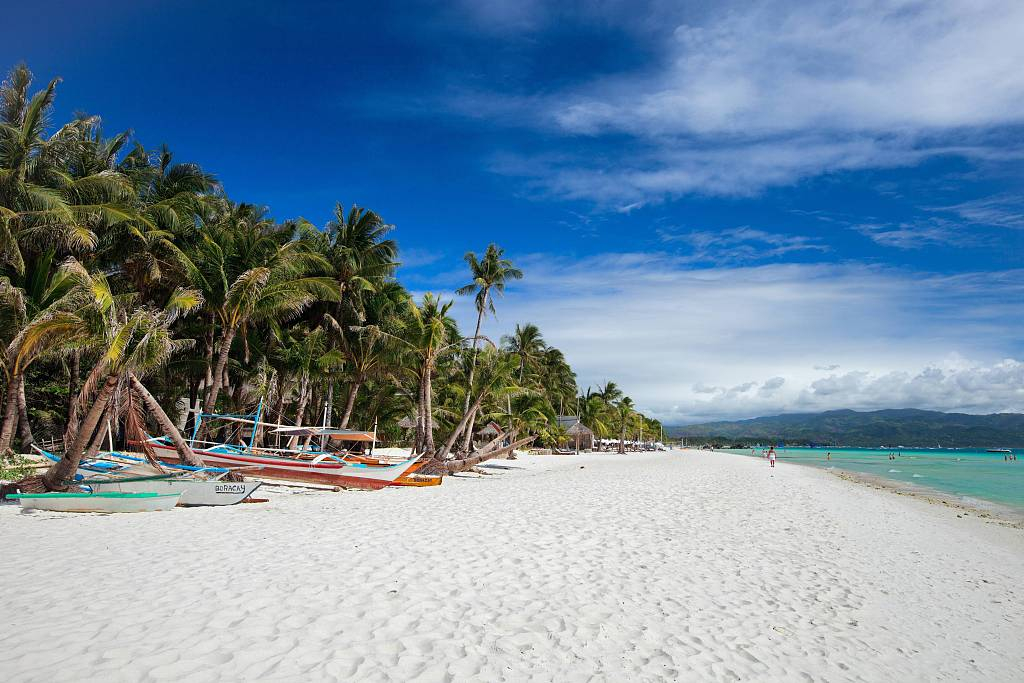It was quite interesting to watch "Boracay Iceman" broadcasting online during his trip to the Crocodile Park in Davao City, the Philippines, with hundreds of viewers watching his livestream and interacting with him in real-time. He was showing viewers crocodiles, asking locals about a unique Philippine fruit or buying some souvenirs for his audience, as playing the role of an online tour guide.

Palm trees and sandy beach in Boracay, the Philippines. /VCG
Palm trees and sandy beach in Boracay, the Philippines. /VCG
The coronavirus epidemic has led to a huge decline in the tourism industry, but livestreaming might be a way for the tourism market seeking for survival. Many well-known museums, scenic areas and historical sites in China have rolled out a series of online exhibitions and live streaming for people trapped at home. Though traveling seems to be hard to realize recently, live streaming provides an outlet for people's leisure time.
Zang Yue goes by "Boracay Iceman" because he owned a travel agency and a spa at Boracay, one of Philippine's top tourist destinations and among the areas that were hit by the COVID-19 epidemic. He started live steaming on Fliggy, a travel app belongs to China's popular e-commerce platform Taobao, from February 23 since the epidemic swept across the world and the Philippines imposed travel restrictions on visitors coming from China and South Korea.
"Over 45 percent of the visitors are from South Korea and the Chinese mainland," Zang told CGTN, "there was a significant decline in tourists when it used to be swarmed with crowds and 70 percent of catering businesses have been shut down in Boracay."
Zang's business is facing a huge dilemma of the lack of cash flow as his travel agency has paid in advance the itineraries booked before China's Spring Festival holiday but visitors can barely show up. Besides, he has to pay the salary of the spa staff.
"One of my business partners introduced me to live streaming and there will be a payment from the online platform," he recalled, "so why not try."

Screenshot of Boracay Iceman's live streaming.
Screenshot of Boracay Iceman's live streaming.
China has become the largest marketplace for live streaming with a large number of users being able to make lucrative careers from it. This is due to the ubiquity of smartphones where many people prefer to consume their entertainment.
According to the data of the Fliggy live streaming platform, there were nearly 30,000 tourism live broadcasts in 2019 and a record of more than 6 million viewers in one live streaming. The cooperation between some live streamers and famous tourism brands, such as Atlantis and Marriott, has brought about tens of millions of yuan of transactions.
Whether it is a real tour display, or trip experience sharing with viewers at home, the interactivity of live streaming is a great way to keep consumers interested while waiting for a strong rebound of consumption after the epidemic.
The Potala Palace, a landmark in southwest China's Tibet Autonomous Region and a UNESCO world heritage, held a live streaming tour session on February 23, the first time in its over 1,300-year history, since it has been shut down since January 27 to prevent the spread of the novel coronavirus. It is estimated that the live streaming received about 920,000 views, more than half of the total visits the palace receives a year.

Screen shot of the live streaming of the Potala Palace, a landmark in southwest China's Tibet Autonomous Region.
Screen shot of the live streaming of the Potala Palace, a landmark in southwest China's Tibet Autonomous Region.
According to Fliggy, the number of daily live streaming on its platform at the beginning of March has doubled compared with that of February. The largest travel livestream agency in China-Global Travel Intelligence Agency launches about 130 live broadcasts per day, with more than 200 travel live streamers covering more than 30 countries and regions around the world. Global travelers are bringing the world's beautiful scenic to online audience trapped at home.
Zang currently planned one to two live streaming a day during his trip to Davao City. Now he has more than 1,700 followers, with 80-100 subscription growth per day.
"Hopefully the tourism market will get better around July and August when the summer vacation comes," he wishes.